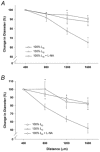Sympathetic nerves inhibit conducted vasodilatation along feed arteries during passive stretch of hamster skeletal muscle
- PMID: 12897176
- PMCID: PMC2343307
- DOI: 10.1113/jphysiol.2003.046284
Sympathetic nerves inhibit conducted vasodilatation along feed arteries during passive stretch of hamster skeletal muscle
Abstract
Ascending vasodilatation is integral to blood flow control in exercising skeletal muscle and is attributable to conduction from intramuscular arterioles into proximal feed arteries. Passive stretch of skeletal muscle can impair muscle blood flow but the mechanism is not well understood. We hypothesized that the conduction of vasodilatation along feed arteries can be modulated by changes in muscle length. In anaesthetized hamsters, acetylcholine (ACh) microiontophoresis triggered conducted vasodilatation along feed arteries (diameter, 50-70 microm) of the retractor muscle secured at 100 % resting length or stretched by 30 %. At 100 % length, ACh evoked local dilatation (> 30 microm) and this response conducted rapidly along the feed artery (14 +/- 1 microm dilatation at 1600 microm upstream). During muscle stretch, feed arteries constricted approximately 10 microm (P < 0.05) and local vasodilatation to ACh was maintained while conducted vasodilatation was reduced by half (P < 0.01). Resting diameter and conduction recovered upon restoring 100 % length. Sympathetic nerve stimulation (4-8 Hz) produced vasoconstriction and attenuated conduction in the manner observed during muscle stretch, as did noradrenaline or phenylephrine (10 nM). Inhibiting nitric oxide production (Nomega-nitro-L-arginine, 50 microM) produced similar vasoconstriction yet had no effect on conduction. Phentolamine, prazosin, or tetrodotoxin (1 microM) during muscle stretch abolished vasoconstriction and restored conduction. Inactivation of sensory nerves with capsaicin had no effect on vasomotor responses. Thus, muscle stretch can attenuate conducted vasodilatation by activating alpha-adrenoreceptors on feed arteries through noradrenaline released from perivascular sympathetic nerves. This autonomic feedback mechanism can restrict muscle blood flow during passive stretch.
Figures





Similar articles
-
Sympathetic neural inhibition of conducted vasodilatation along hamster feed arteries: complementary effects of alpha1- and alpha2-adrenoreceptor activation.J Physiol. 2005 Mar 1;563(Pt 2):541-55. doi: 10.1113/jphysiol.2004.072900. Epub 2004 Dec 2. J Physiol. 2005. PMID: 15576454 Free PMC article.
-
Spread of vasodilatation and vasoconstriction along feed arteries and arterioles of hamster skeletal muscle.J Physiol. 1999 Apr 1;516 ( Pt 1)(Pt 1):283-91. doi: 10.1111/j.1469-7793.1999.283aa.x. J Physiol. 1999. PMID: 10066941 Free PMC article.
-
Interaction between sympathetic nerve activation and muscle fibre contraction in resistance vessels of hamster retractor muscle.J Physiol. 2003 Jul 15;550(Pt 2):563-74. doi: 10.1113/jphysiol.2003.038984. Epub 2003 May 16. J Physiol. 2003. PMID: 12754308 Free PMC article.
-
Integration of blood flow control to skeletal muscle: key role of feed arteries.Acta Physiol Scand. 2000 Apr;168(4):511-8. doi: 10.1046/j.1365-201x.2000.00703.x. Acta Physiol Scand. 2000. PMID: 10759588 Review.
-
Conducted vasomotor responses in arterioles: characteristics, mechanisms and physiological significance.Acta Physiol Scand. 1999 Sep;167(1):11-21. doi: 10.1046/j.1365-201x.1999.00603.x. Acta Physiol Scand. 1999. PMID: 10519972 Review.
Cited by
-
Sympathetic neural inhibition of conducted vasodilatation along hamster feed arteries: complementary effects of alpha1- and alpha2-adrenoreceptor activation.J Physiol. 2005 Mar 1;563(Pt 2):541-55. doi: 10.1113/jphysiol.2004.072900. Epub 2004 Dec 2. J Physiol. 2005. PMID: 15576454 Free PMC article.
-
Spreading dilatation to luminal perfusion of ATP and UTP in rat isolated small mesenteric arteries.J Physiol. 2007 Jul 1;582(Pt 1):335-47. doi: 10.1113/jphysiol.2007.135202. Epub 2007 May 3. J Physiol. 2007. PMID: 17478526 Free PMC article.
-
Integration and Modulation of Intercellular Signaling Underlying Blood Flow Control.J Vasc Res. 2015;52(2):136-57. doi: 10.1159/000439112. J Vasc Res. 2015. PMID: 26368324 Free PMC article.
-
Regulation of blood flow in the microcirculation: role of conducted vasodilation.Acta Physiol (Oxf). 2011 Jul;202(3):271-84. doi: 10.1111/j.1748-1716.2010.02244.x. Epub 2011 Mar 1. Acta Physiol (Oxf). 2011. PMID: 21199397 Free PMC article. Review.
-
Revisiting the Venoarteriolar Reflex-Further Insights from Upper Limb Dependency in Healthy Subjects.Biology (Basel). 2024 Sep 12;13(9):715. doi: 10.3390/biology13090715. Biology (Basel). 2024. PMID: 39336142 Free PMC article.
References
-
- Bowling N, Huang X, Sandusky GE, Fouts RL, Mintze K, Esterman M, Allen PD, Maddi R, McCall E, Vlahos CJ. Protein kinase C-alpha and −epsilon modulate connexin-43 phosphorylation in human heart. J Mol Cell Cardiol. 2001;33:789–798. - PubMed
-
- Burkholder TJ, Lieber RL. Sarcomere length operating range of vertebrate muscles during movement. J Exp Biol. 2001;204:1529–1536. - PubMed
-
- Chen BM, Grinnell AD. Integrins and modulation of transmitter release from motor nerve terminals by stretch. Science. 1995;269:1578–1580. - PubMed
-
- Emerson GG, Neild TO, Segal SS. Conduction of hyperpolarization along hamster feed arteries: augmentation by acetylcholine. Am J Physiol Heart Circ Physiol. 2002;283:H102–109. - PubMed
-
- Emerson GG, Segal SS. Electrical coupling between endothelial cells and smooth muscle cells in hamster feed arteries: role in vasomotor control. Circ Res. 2000a;87:474–479. - PubMed
Publication types
MeSH terms
Substances
Grants and funding
LinkOut - more resources
Full Text Sources

